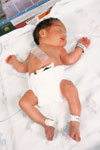More info: Evaluation
Neurological evaluation
Useful information can be gained simply by observing the baby's posture, alertness, and level of activity. A normal term baby lies flexed in the fetal position with the hands closed, whereas a premature baby sprawls out with the hands open.
 A normal baby is easily awakened by taking off the covers or by stimulating the foot or the cheek, while a depressed baby is poorly responsive and quickly goes back to sleep.
A normal baby is easily awakened by taking off the covers or by stimulating the foot or the cheek, while a depressed baby is poorly responsive and quickly goes back to sleep.
A full-term baby with decreased flexor tone and lying with the limbs extended may either be floppy or have increased extensor tone. This calls for immediate further evaluation for intracranial pathology, muscle disease, or a systemic disorder such as hypotension or infection.
Cranial nerves may quickly tested by eliciting the pupillary responses and blink reflex to light (II), doll's eye phenomenon (III, IV, VI), corneal, sucking, and rooting reflexes (V, VII), response to noise or sound (VIII), and the gag reflex (IX, X).
The integrity of the lower brain centers can be checked by eliciting the neonatal reflexes: Moro reflex, grasp reflex, sucking and rooting reflex, and the stepping reflex. In addition, the Moro reflex is useful in establishing that movements of the extremities are symmetrical.



